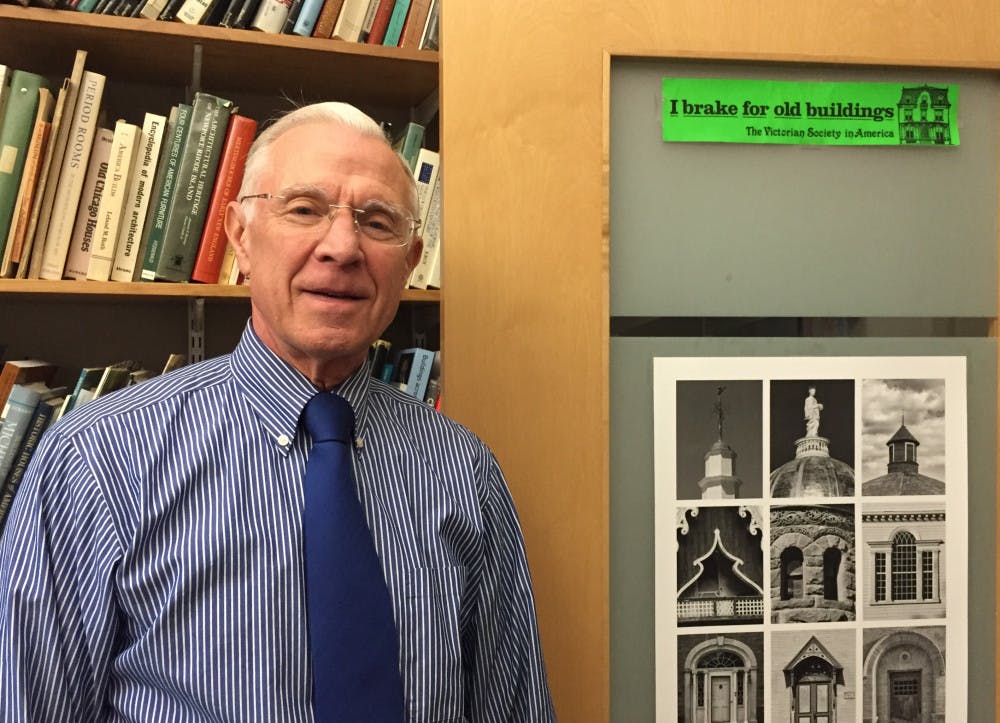“What I try to do is to get people to start looking around them,” Professor of the History of Art and Architecture Glenn Andres said, reflecting on his retirement at the end of this semester. In his 45 years teaching classes such as Art of the City, Andres has made “looking around” valuable and exciting for Middlebury students.
Hired in 1970, Andres has witnessed the College’s immense growth. He described his first years at the College co-teaching a general art survey course or, as he called it, Art 101 in Dana Auditorium filled to capacity.
“It was almost like a circus.” Andres recounted. “There was one class when students walked up and down the aisles as if they were popcorn vendors. Another time, a group of students streaked during lecture.”
This was before the Arts as an academic field had been developed as an essential component of a Liberal Arts education; a process Andres has played an integral role in advancing during his tenure. In particular, Andres has helped the Architectural studies program evolve from informal independent study meetings to one of the most respected undergraduate programs in the country.
“Glenn Andres is the founding father of Architectural Studies at Middlebury,” Professor of the History of Art and Architecture, Pieter Broucke wrote in an email. “Over the last four decades [he has] put Middlebury on the map as one of the few places where architecture can be explored at the undergraduate level.”
While Andres has undoubtedly witnessed much change on this campus, when asked about differences in the student body that have occurred during his time, Andres sees continuity where others see fluctuation. “People say students change, I’m not so sure they do all that much, “ he said. “Middlebury students have always been the kind of students who once they find their passion, there is no limit to what they can accomplish.”
Andres and the College’s student body have this ambition in common; in addition to the aforementioned accomplishments, Andres has been a source of knowledge and inspiration for Middlebury students and colleagues.
Architectural studies major, Eliza Margolin ’15 described Andres as eloquent and thoughtful.
“Glenn is easily the best lecturer I have had a Middlebury. He is so knowledgeable about such a breadth of topics that sitting in class with him is just plain fun,” Margolin wrote in an email.
Brandon Gell ’16, also an architectural studies major, said, “Professor Andres was by far the most inspired lecturer I ever experienced. So incredibly dedicated to thoroughly understanding the material he was teaching.”
Kristen Hoving, professor of the History of Art and Architecture also spoke highly of Andres.
“For the 32 years I have been at Middlebury, Glenn Andres has been a model of devotion to his students, excellence in the classroom, insightful scholarship, and committed citizenship,” Hoving wrote. “It’s hard to imagine the department without him.”
In addition to Andres’ invaluable involvement in the academic focus on art and architecture at the College, he has also assisted in the campus’ architectural evolvement. Andres served on planning committees for buildings such Bicentennial Hall, Ross and Atwater Commons, and also chaired the committee for the planning of the Davis Family Library and the Axinn Center. In the late 1980s Andres was involved in the early stages of the architectural planning of the Mahaney Center of the Arts (CFA). Andres remembers giving renowned American Architect, Robert Venturi a tour of Middlebury’s campus when Venturi was being interviewed to design the CFA.
“Venturi got out of his rental car, looked around, turned to me and said, ‘Do you know what you have here? You have what every person thinks an American college campus should like, except they almost never do,’” Andres related.
On campus, Andres’ favorite architecture is Old Stone Row because “it is iconic of the College,” and in the town of Middlebury, “hands down,” the Congregational Church, as according to Andres, it is one of the finest federal style churches in New England.
Colleague John Hunisak commented on Andres’ invaluable contribution to creating the architectural studies program and his “remarkable ability always to remain calm and reasonable.” He also recounted a common quote of Andres’ that represents his temperament and good nature: “Never attribute to malice what can be explained by stupidity.”
Most recently, Andres co-authored a book, twenty years in the making, Buildings of Vermont. The book is a history of Vermont architecture, highlighting the wide variety of building styles in the state.
In keeping true to the bumper sticker hanging on his door that reads, “I brake for old buildings,” Andres has recognized the diversity and significance of existing Vermont architecture and hopes to inspire that same appreciation among others.
Though he has exciting plans to travel to Sicily in the fall, Andres said, “I will miss watching each new generation of students begin to see the world about them with new eyes.”
Glenn Andres, Architect & Professor, Retires After 45 Years

Comments


